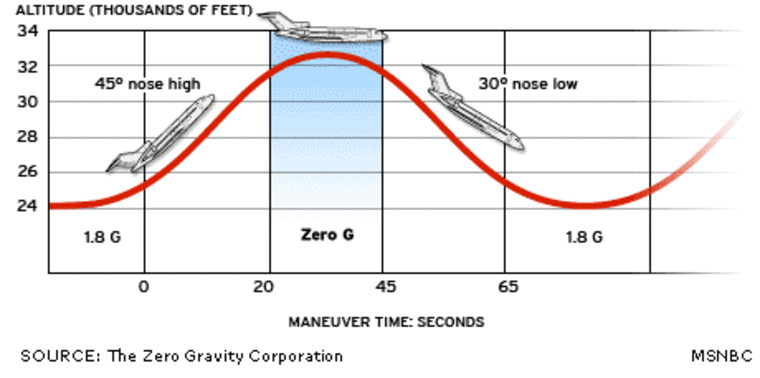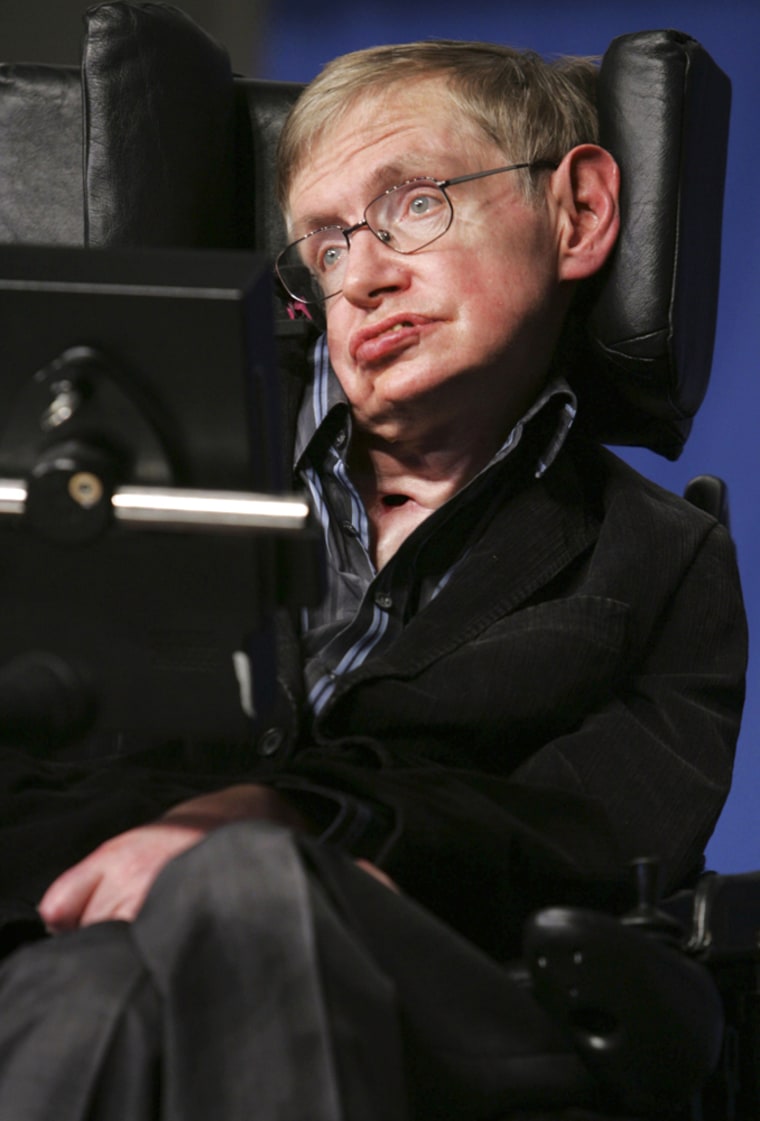British physicist Stephen Hawking, who is world-famous for his intellectual prowess as well as his physical frailty, has made a firm date with weightlessness on April 26, aboard a jet flying out of NASA's Kennedy Space Center in Florida.
Hawking's excellent adventure, provided by California-based Zero Gravity Corp., would represent one small step toward the 65-year-old scientist's goal of flying in space as early as 2009 — as well as one giant leap for people with disabilities.
"As someone who has studied gravity and black holes all of my life, I am excited to experience, firsthand, weightlessness and a zero-gravity environment," Hawking said Thursday in a written statement released by Zero Gravity. "I am thankful to Zero Gravity Corp. for making this experience available to the general public, especially for disabled individuals."
The zero-gravity airplane flight produces the feeling of weightlessness for about a half-minute at a time, by following a parabolic up-and-down path at an altitude of 30,000 feet. As the plane crests the top of the parabola, the passengers and other objects in the stripped-down, padded cabin essentially go into free-fall — floating in the air as if they were in orbit.
More than 2,500 fliers have gone on Zero Gravity's aerial roller-coaster ride, usually paying thousands of dollars for the privilege. Hawking, who is almost completely paralyzed due to a degenerative nerve disease called amyotrophic lateral sclerosis or ALS, would be the first quadriplegic to do so.
Hawking's flight will have an extra philanthropic twist: Several charitable organizations — including Easter Seals, the Starlight Starbright Children's Foundation, the X Prize Foundation and Augie's Quest — will each be given two seats aboard the plane to auction off for fund-raising.
Peter Diamandis, the chief executive officer of Zero Gravity as well as the chairman of the X Prize Foundation, said flying Hawking would be "truly an honor."
"Our mission is to make the excitement and adventure of space and weightlessness accessible and enjoyable," he said in the statement. "Flying Professor Hawking helps us demonstrate how this unique experience, once available only to astronauts, is now available to everyone."
Zero Gravity's specially outfitted Boeing 727-200 jet flies from the Shuttle Landing Facility at Kennedy Space Center under the terms of a commercial agreement with NASA. Hawking's flight is scheduled during the current launch window for the shuttle Atlantis' mission to the international space station — and the zero-G flight would have to be rescheduled if it interferes with NASA's launch plans.
Space Florida, the organization charged with promoting commercial space in the state, is a sponsor of Hawking's flight.
Months of talks
The announcement that the flight is a "go" comes after months of talks involving Zero Gravity, Hawking and his representatives — and even the Federal Aviation Administration. Further talks still must take place: "Zero-G and its partner, Amerijet, are working with the FAA to put the final procedures in place," Diamandis told MSNBC.com Thursday.
The idea got its start last November, when Hawking told an interviewer that he hoped to accomplish a number of goals before he died. "My next goal is to go into space," he said. Hawking added that Virgin Galactic's billionaire founder, Richard Branson, might help him reach that goal.
That comment prompted invitations not only from Zero Gravity, but also from Virgin Galactic, which is planning to offer suborbital space tours beginning in the 2009.
"We're talking with Dr. Hawking," Jackie McQuillan, a spokeswoman for Virgin Galactic, told MSNBC.com this week. But she said there were not yet any firm arrangements to put him on a future spaceflight. Hawking has not gone through a medical checkout, she said.
Concerns about medical condition
Hawking's safety is the top concern for the flight aboard Zero Gravity's jet, Diamandis said.
Parabolic flights can pose a risk of motion sickness or more serious health effects, but Zero Gravity's flights have been structured to minimize the risk. During a typical flight, Zero Gravity's "G-Force One" jet makes a gradual transition to weightless parabolas, and provides significantly fewer bouts of weightlessness than NASA's "Vomit Comet" jet.
Hawking would board the plane in his wheelchair, just as he boards any commercial jet. When the jet reaches about 20,000 feet in altitude, "his assistants will carry him from his seat into the float zone," Diamandis said. He would lie down with medical attendants at his side and coaches at each of his four limbs, then wait for the weightlessness to take effect.
"He will be floating free of his wheelchair — I assume in his flight suit," Diamandis said.
Hawking would be closely monitored during each parabola, and would have to signal his go-ahead for each succeeding bout of weightlessness, Diamandis said. "Our goal is to do three — and if he ends up doing more, so be it," he said.
When the parabolas end, Hawking would be returned to his seat for a normal airplane landing.

Jay Buckey, a physician and former astronaut who is now a professor at Dartmouth Medical School, said Hawking would face a "good side and a bad side" during a zero-G flight.
"Being weightless like that doesn't require you to have that much strength in your limbs, so in that sense it would be freeing," he told MSNBC.com. However, the fluctuations between weightlessness and a double dose of gravity could put extra stress on Hawking's cardiovascular system, he said.
The potential for injury would be another concern, said Jon Clark, space medicine liaison at the Houston-based National Space Biomedical Research Institute. Clark, who has flown on Zero Gravity's plane as well as NASA's zero-G jet, said fliers are prone to crash into things, particularly when gravity returns at the end of each parabola. That could pose a special threat for Hawking. "You do have to wonder how fragile his bones are, having been in that condition for so many years," Clark told MSNBC.com.
Looking beyond the immediate health concerns, Clark said Hawking's flight could contribute to the field of space medicine.
"There's so little insight into these kinds of issues," he said. "I hope they thoroughly study him, because it's breaking new ground."
A model for people with disabilities
When the possibility of a zero-G adventure first came up in November, McMahon told MSNBC.com that his company would be honored to provide a free flight in recognition of Hawking's "unique contribution" to science. The Cambridge professor has focused on the farthest frontiers of cosmological theory, addressing the nature of black holes and our quantum universe.
Slideshow 12 photos
Month in Space: January 2014
McMahon said Hawking's flight also could serve as a model for accommodating other people with disabilities, on zero-gravity airplane flights as well as future space trips. "If you're bound to a wheelchair, there's nothing more exciting than being able to float free," he said back in November.
Andrew Imparato, president and chief executive officer of the American Association of People with Disabilities, said a successful zero-gravity flight would send a positive message not only to wheelchair-users, but to society at large.
"There are parallels to having the first woman in space, or the first African-American in space," Imparato told MSNBC.com this week. "For somebody who has a significant disability to do that, pushing the boundaries of the human experience ... it can certainly expand the way people think about disabilities."

